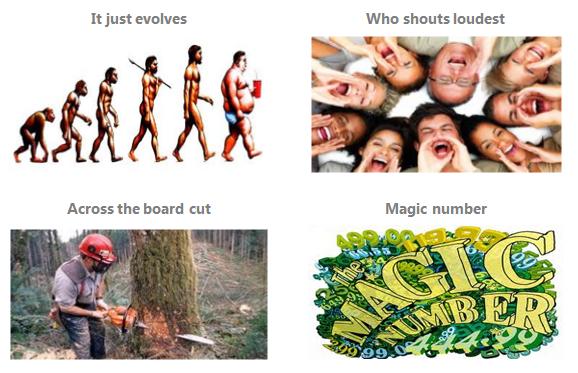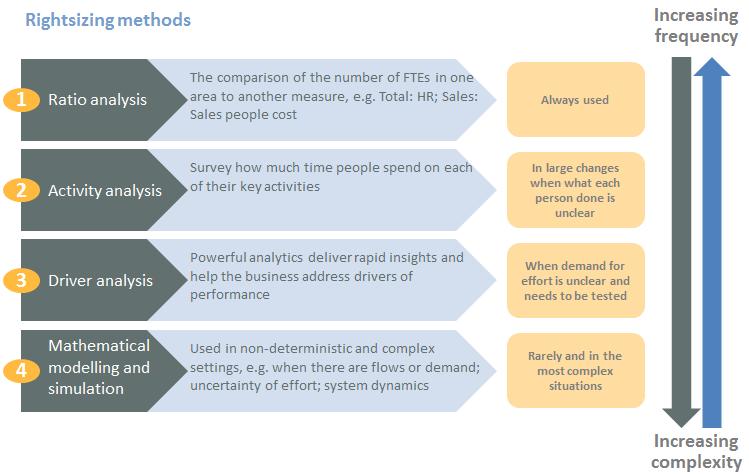Rightsizing: stop basing your headcount on who shouts loudest
Four basic analytical techniques to help organizations answer the rightsizing question.
Typically, rightsizing just isn’t done in anything like the type of rigor it deserves. Whether this is because it’s the political hot potato no one dares to touch or simply the lack of rigor and tools to think about it.
Rightsizing is the decision on how many people, and how much effort to invest against any set of activities. The outcome is a staff profile or resource plan. The outcome is the amount of talent dedicated to any particular area.
Given how important these decisions are, it amazes us how little time is dedicated to thinking about it. For instance, after reviewing the ten most prominent books and 20 most circulated white papers on organizational design, this topic isn’t mentioned. Structure is, big time. Process is and lateral capability is there, as is option analysis and the link to strategy or competencies and organizational health. But not how to determine the number of people to employ.
So, how is right-sizing typically done? Here are four methods employed in practice:

The most common is, “it just is”. It evolves. Decisions are made for one reason or another and a shape is created. Not by design or conscious thought, but by an evolutionary process. That evolution is often driven by who shouts the loudest, by managers who are adept at getting their way and ensuring they have the resource. Just like wages have a ‘price stickiness’ – a term economists use, which basically means that people don’t take pay cuts – so too does headcount. A decision to create a role or increase headcount has a ‘stickiness’. Last year’s budget is the basis for this year’s budget. This works until there is a shock. When that shock happens, Finance demands cuts. Because it’s so hard, those cuts are made across the board and in a unilateral way. “It has to be by 20%”. Sometimes more rigor is required, so a benchmark or a ‘magic number’ will be used as a justification. A sense of rigor is provided. But is that really rigor or an easy way out?
The issue is: any one number is dangerous. Benchmarks are rarely apples-for-apples comparisons and are too often based on a tiny sample. Proper thought is required.
At Orgvue we leverage four basic analytical techniques to help organizations answer the rightsizing question.
Rightsizing methods

Ratio analysis is what people use in their benchmarks. It’s a set of comparisons. Span of control is a ratio, as is the number of FTEs that each desktop support person supports. The key is not being blinded by one number, but by building up a picture.
Activity analysis is effectively a survey or study of the amount of time that each person spends on their main activities. What people actually do, and what their job descriptions say they do, which are gathering dust in a drawer somewhere anyway, are typically worlds apart. Job titles are of little additional help. The question is: So how do people spend their time? There are surprisingly simple techniques to answer this. Surprising in the sense that, yes it is still a pretty considerable effort but not the impossibility that is assumed by most.
Driver analysis is an extension of ratio and activity analysis. What is the driver of effort? If that driver changes, what is the impact of resource? For instance, drivers for a call center are the number of calls, flow of calls, service levels demanded, skills needed, time in grade and therefore time to resolve a case. In other words, there are numerous influences. This fact of multiple drivers is why we caution so strongly against the myth of the magic number.
Lastly, the one that most certainly confused most readers, is “mathematical modeling”. Each analytical technique increases its levels of sophistication and ability to deal with complexity. The jumps are not linear but exponential. As answers, they are orders of magnitude harder to provide and therefore should be used, sparingly. Use this last one when there are system dynamics are play and when it’s not a set of deterministic linear drivers. We have done this in radiotherapy centers with changes in technology & working patterns and in packaging distribution centers to demonstrate the impact of introducing delivery waves and process automation.
This is a big topic. One that scares so many. One which deserves proper debate – because even if the debate isn’t had openly, the decisions are still being made. So, have the debate. We believe in fronting up to this challenge. We believe it is right to think the challenge through and apply the appropriate level of analytical tooling to address the level of complexity in the given circumstance. We have shown four clear techniques that can be used. If they’re not, the headcount of any organization will just evolve until the shock slash and burn moments arrive. We believe the choice is clear. Make the effort and apply the thinking or live in a world of victim-felt cuts and politically driven shouting managers. As Einstein said, “Everything should be made as simple as possible, but not simpler.”